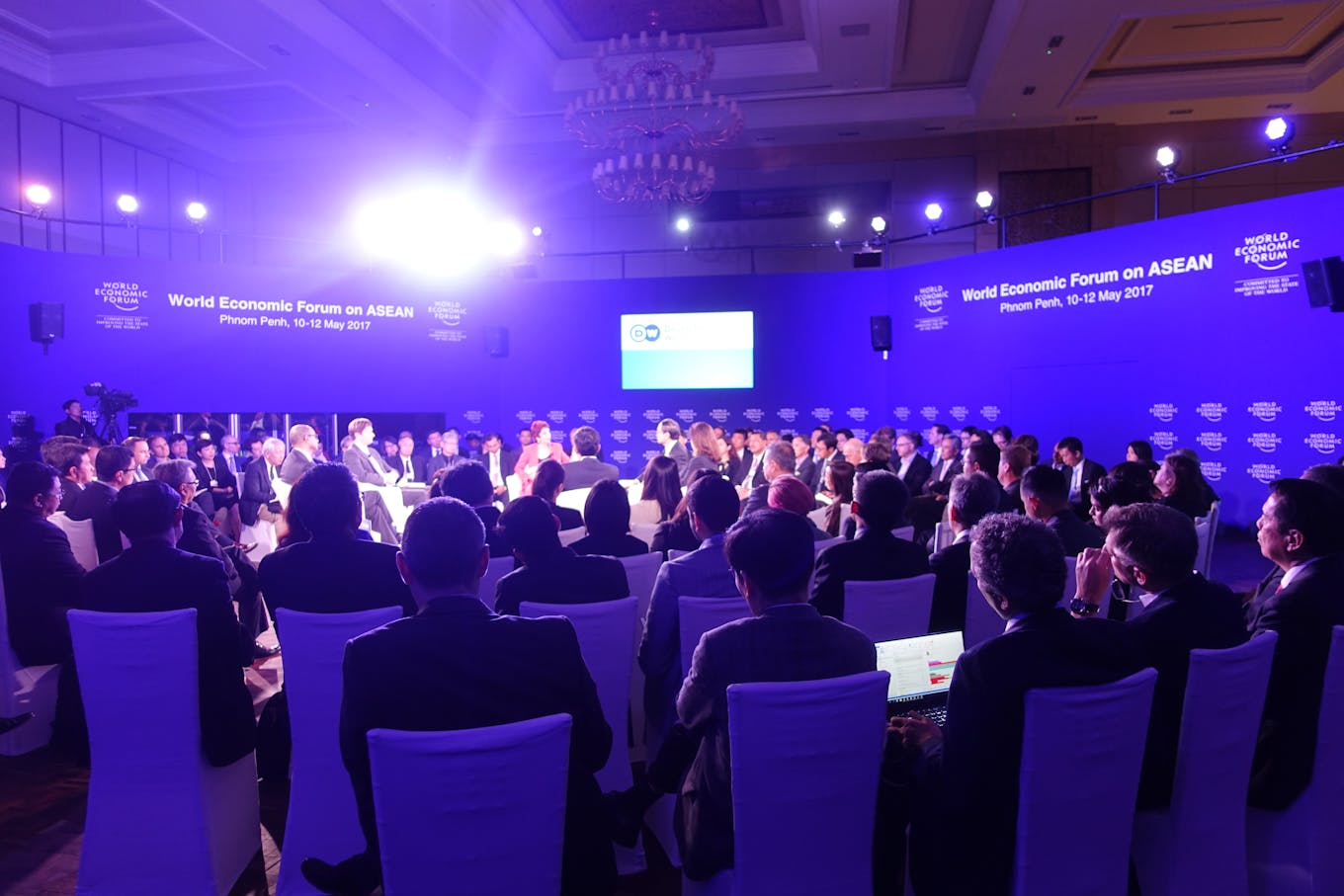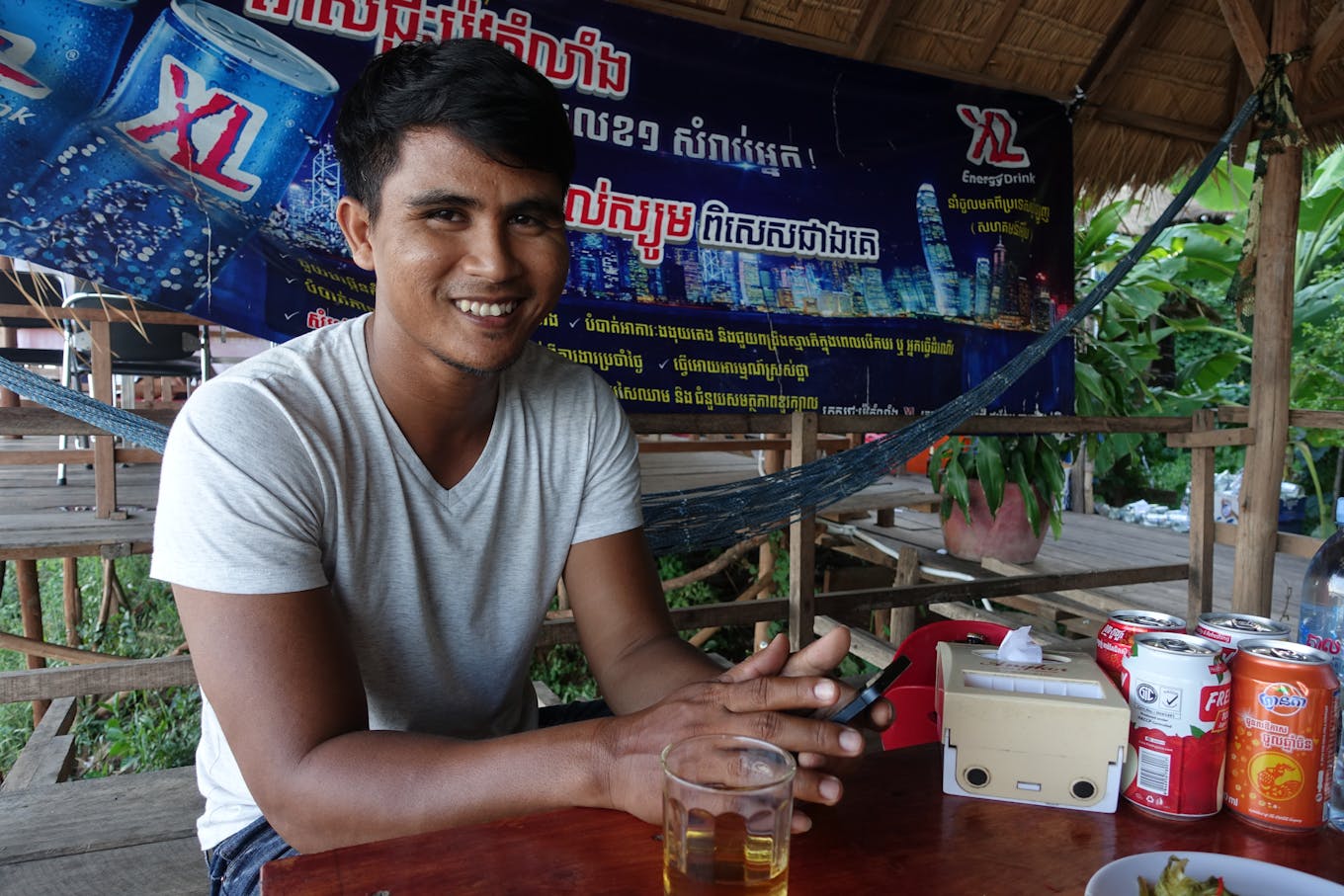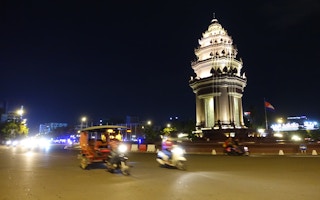Cambodian Leng Bunny, 30, is a tuk-tuk driver ferrying visitors like me in Phnom Penh to their destinations. He moved to the capital to find a job when he was 17 and he currently makes an average of US$500 a month – about half of Cambodia’s gross national income per capita of US$1,070, according to latest World Bank statistics.
To continue reading, subscribe to Eco‑Business.
There's something for everyone. We offer a range of subscription plans.
- Access our stories and receive our Insights Weekly newsletter with the free EB Member plan.
- Unlock unlimited access to our content and archive with EB Circle.
- Publish your content with EB Premium.
Bunny speaks in halting English – which he studied part time at a private school – but he is politically astute, able to converse with me about Cambodian politics. He knows that Asean is the regional grouping of Southeast Asian nations, a bloc like the European Union, but he is ambivalent about how being part of Asean will be beneficial to him.
Bunny added me on Whatsapp on his iPhone 4 so we could coordinate our trips. He tells me he goes to coffee shops with free wi-fi in his spare time and spends close to five hours each day on his phone, making online purchases or consuming news on Facebook. His ambition is one day to be able to afford a car so he can be a taxi driver and provide a comfortable life for his wife, a housewife, and his six-year-old son.
Bunny is the face of the youth in Asean, where more than half of its 630 million population are under the age of 30. Together, the bloc represents the fastest-growing internet population in the world with the number of people with internet access growing by 124,000 each day – a pace that will remain for the next five years.
This digital connectivity spells huge transformation for Asean economies as their infrastructure needs grow, the nature of jobs evolve, and the opportunities and ways of living for the young contrast sharply with the past.
So, how will Asean countries manage this transition and integrate its economies for sustained growth in the next 50 years?
This was the dominant question at the recently-held World Economic Forum (WEF) on Asean – held in Cambodia for the first time - on 10 to 12 May, which attracted more than 700 participants from 40 countries.
Through the three days of discussions, one message was loud and clear: Asean is open for big business.
Government delegations were eager to enthuse the forum about the business opportunities in the region. In one briefing, the Philippines sent almost its entire Cabinet to address the media and launch President Rodrigo Duterte’s economic agenda dubbed “Dutertenomics” - a US$173 billion infrastructure programme with the slogan “Build, Build, Build” that is seeking private sector partners.
From 2017 to 2021, Asean economies are expected to grow at an enviable 3 to 8 per cent, powered by the IT sector which is poised to add US$1 trillion to Asean GDP by 2027, and will create revolutions in financial technology, e-commerce and improved governance, says WEF.
Underpinning this growth will be a massive infrastructure boom, which its leaders say is key to promoting economic and social development as well as reducing poverty. The Asian Development Bank estimates that US$26 trillion in investment by 2030 will be required to meet the region’s infrastructure needs.
Once built, these projects will be locked in for decades and will determine the success of the region – it is therefore crucial that Asean countries get it right.
How will it do so?
Asean needs to put sustainable development at the front and centre of its obsession with growth.
Sustainable development refers to development that meets the needs of the present without compromising the needs of future generations. Its awareness has been on the rise, driven by the 17 United Nations’ Sustainable Development Goals (SDGs), which were adopted by nations in 2015 to guide global development and address challenges such as poverty, health, education and climate change.
Asean’s growing population – estimated to reach 741 million by 2035 – combined with rapid economic growth and region-wide social inequities, have already been exerting pressure on the bloc’s natural resources.
This has resulted in numerous transboundary environmental issues such as air, haze, water and land pollution, along with the depletion of natural resources and biological diversity.
Southeast Asia has the most wood per hectare of forest of anywhere on Earth and some of the richest biodiversity. But this is under serious threat; some parts of the region are projected to lose up to 98 per cent of their remaining forests over the next nine years, according to a new study published in the journal Ecosphere.
Asean’s tough balancing act between environmental sustainability and economic development is also made more difficult by the increased consumption of resources and waste generation fuelled by a burgeoning middle class.
At the forum, there were encouraging noises made by some leading figures about sustainable growth.
Prime Minister of Vietnam, Nguyen Xuan Phuc, told delegates that Asean “cannot rely on natural resources and unskilled labour but have to strive towards sustainable development and better quality growth so we can move up the value chain.”
Greta Faremo, United Nations Under-Secretary-General, also stressed that Asean must “build inclusivity and sustainability into its infrastructure and institutions right from the start.”
Given the backlash against globalisation and regional integration seen in Europe and the United States in recent years, it is all the more imperative that Asean’s growth is inclusive, she pointed out.
By and large, though, the conversation on sustainable development was only a side event to the main gig. It remains to be seen whether Asean countries will be able to convert the rhetoric into deliverable outcomes.
For the 10-nation bloc to achieve sustainable growth, it needs to focus on two things – domestic challenges and region-wide cooperation.

The World Economic Forum on Asean — which saw political and business elites discussing issues on youth, technology and growth — was held in Cambodia for the first time from 10 to 12 May 2017. Image: Eco-Business
National challenges
Asean countries are in varying stages of development but will confront similar challenges. These include providing relevant jobs for their labour force, strengthening governing institutions and boosting social safety nets – against the backdrop of growing energy consumption amid climate change and dwindling natural resources.
Dr Janil Puthucheary, Singapore’s Senior Minister of State for the Ministries of Education and Communications and Information, who spoke at the forum, stressed that education is a top priority to deliver inclusive growth in the next stage of Asean’s development.
The fundamentals of numeracy and literacy education – and getting the “values behind it right” – will affect how countries deal with disruptive technologies, he said. How Asean governments will deliver the required education and skills training to its growing population is the question.
“
By and large, though, the conversation on sustainable development was only a side event to the main gig. It remains to be seen whether Asean countries will be able to convert the rhetoric into deliverable outcomes.
Anies Baswedan, Minister for Education of Indonesia, recently remarked: “We have 21st-century students, but 20th-century teachers and 19th century classrooms”.
Reforms are needed such that education systems “teaches new skills: financial literacy, cultural literacy, IT literacy. And on top of that, we have to emphasise creativity, critical thinking, collaboration and communication … these are the skills workers will need in the future,” he added.
The bigger challenge would be tackling inequality and ensuring that no one gets left behind. Take Cambodia, for instance. Its Prime Minister Hun Sen gave high profile speeches embracing Asean’s vision for a highly integrated and inclusive economy with a single market by 2025, but the country has a spotty record when it comes to inclusive growth.
While it has opened its doors to foreign direct investment in the past two decades and enjoyed such spectacular growth that it has earned the name the “New Asian Tiger”, large swathes of its population remain in poverty. The country’s garment workers, for instance, who power a multi-billion dollar industry accounting for a third of national GDP, earn a wage that is reported to be second-lowest in the world, after Bangladesh.
Over the past decade, Cambodia has also been awash with land-grabs and the forced evictions of peasants from their homes and farms as industrial agri-firms take over.
Then there is the issue of governance and civil liberties, which are intrinsically tied to the concepts of sustainable development and inclusive growth.
In a recent piece for WEF, Professor Syed Munir Khasru, chairman of the Bangladesh-based Institute for Policy, Advocacy and Governance, noted that while Asean has performed exceptionally in economic terms, the same cannot be said for the progress of civil liberty and human rights.
Most Asean nations still have heavy restrictions on media, civil society, and freedom of speech, but with the proliferation of the internet, the speed of technological innovation is likely to outsmart the capability of centralised surveillance authorities, wrote Khasru.
“The longer Asean waits in reforming its governance and human rights conditions, the riskier the political environment of the region would become,” he noted, hinting at the possibility of an Asean Spring.
Asean leaders should therefore start reforming the socio-political culture by giving its citizens more freedom and space, he recommended.

Leng Bunny, one of many in Cambodia’s young population, drives a tuk-tuk in Phnom Penh to make a living. Image: Eco-Business
Is Asean just a slogan?
Region-wide, Asean countries need to deepen their cooperation on everything from the Asean Economic Community, which envisions Asean as a single market and production base, to transboundary environmental issues, food security and infrastructure connectivity.
Its track record on region-wide cooperation, however, is not the most stellar. The Asean Power Grid formed by Laos, Thailand, Malaysia and Singapore, which aims to connect the electricity grids of Asean countries and facilitate energy trading and improve efficiencies, for instance, has been 20 years in the making with no sign of it being close to being fulfilled due to the bloc’s slow consensus-making process.
Asean nations also continue to build massive fossil-fuel powered plants. If it does not make the opportunity to transition to renewables fast enough, it may well find itself behind the rest of the world in 50 years’ time – still dependent on fossil fuels, facing environmental problems and with new challenges such as an ageing population.
The other elephant in the room is corruption. While there were discussions on transparency and governance, most conversations at WEF sidestepped the thorny issue of corruption, which is still highly prevalent – especially in natural resource industries – in many developing Asean nations.
Many failed infrastructure projects, for instance, are linked to corruption. If Asean nations – and the wider global private sector - are investing all this money in infrastructure growth, then there is an urgency to look at reforming market structures and state-owned enterprises, planning, financing, and the strengthening of governing institutions.
So, will the coming years be any different for Asean?
Perhaps in this respect, a new initiative announced by WEF late last month may provide an accelerated path for Asean.
The forum’s Asean regional strategy group – consisting of 26 Asean CEOs, government ministers and academics – has proposed to study different regional integration models around the world, such as the European Union, NAFTA (North American Free Trade Agreement), Mercosur and others, with a view to identifying novel ideas for Asean.
WEF says the study will also look at how the fourth industrial revolution changes the modus operandi of regional cooperation. President Rodrigo of the Philippines and Chair of Asean in 2017 has invited the group to present the ideas at the next Asean Heads of State meeting in Manila in November.
It is also important to note that in hosting WEF on Asean for the first time, Cambodia is also taking a big step in further engaging the international community – a move that invites foreigners and scrutiny into the country – which can only improve openness and transparency.
As this conversation evolves, sustainable development needs to be at the foreground of the discussion about Asean’s future. WEF, as a thought leader in global affairs, can also play a key leadership role in ensuring that it stays top of the regional agenda.
If Asean’s leaders get it right, the future will no doubt be bright for those like Bunny, who crave opportunities to improve their lot, and for their children to have better lives.











